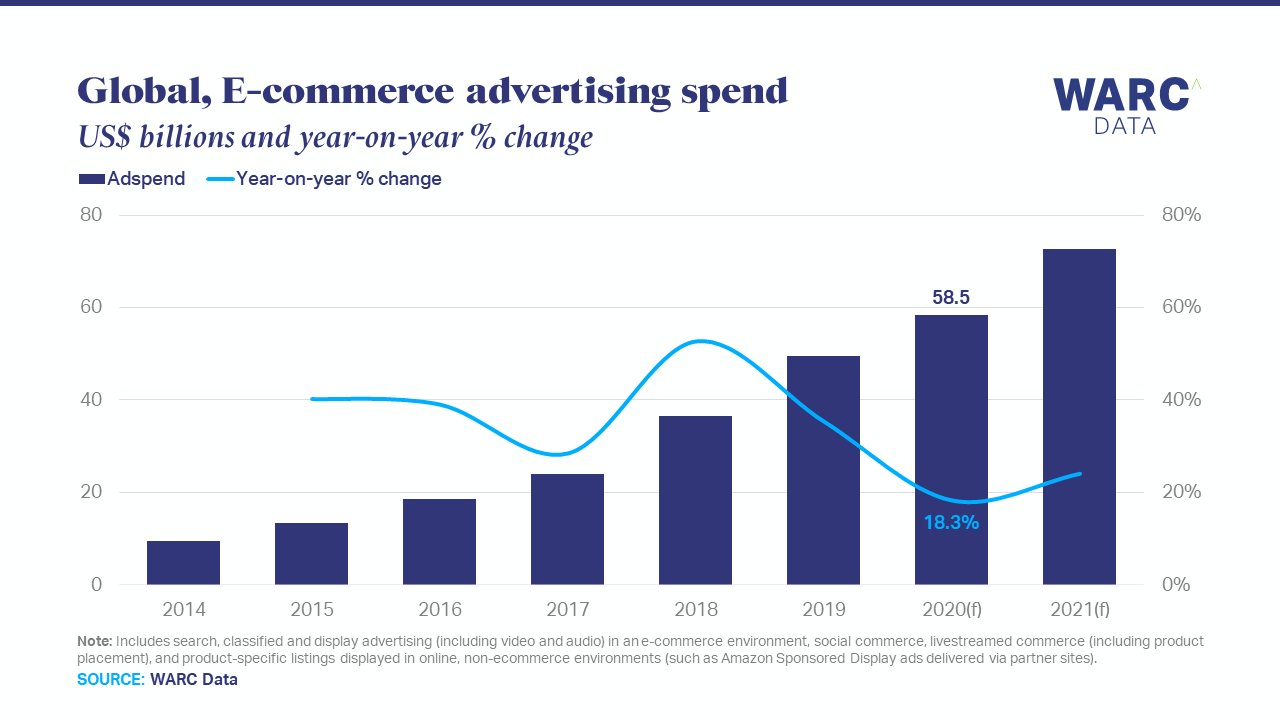Shoppable media is the latest marketing opportunity and WARC’s Gabey Goh says the upcoming eTail Asia 2021 conference will outline the key drivers of this shoppable trend and what it means for marketers.
What’s next? That’s the question that attendees at the upcoming eTail Asia 2021 conference will be looking to answer as retail brands, e-commerce practitioners and marketers find themselves facing a landscape that has arrived years early, thanks to the COVID-19 pandemic.
Online shopping has now become the norm for most consumers and continued improvements in digital technology have enabled more retail brands to get closer to the long-sought ideal of a holistic and personalised shopping experience.
Amidst discussions about data, frictionless experiences and omnichannel strategies, one emerging area that brands have only just begun to tap is shoppable media. The notion of seizing “shoppable moments” is not new and marketers have been redeploying ad budgets to reach consumers at shoppable moments for some time.

In 2020, an estimated US$58.5 billion was spent on advertising across e-commerce platforms globally, representing year-on-year growth of 18.3%, a rate 30 times faster than the wider online ad market and in stark contrast to an expected 8.1% decline in total ad investment.
The topic has gained greater emphasis in recent months, thanks to shifts in consumer behaviour and media consumption patterns. Simply put, we are now spending more time and money within online environments.
This shift to shoppability has benefitted e-commerce platforms like Flipkart, Alibaba, Shopee and Lazada, as well as omnichannel retailers who are also building out sizeable media businesses to capture the opportunities and revenue that come from shoppable content.
Not to be left behind, social and video platforms including Facebook, YouTube, Pinterest and TikTok are looking to China for inspiration and hastily assembling their own “shoppable” ad formats, enabling users to instigate and, increasingly, complete purchases without leaving the content they are consuming.
Our recent WARC Guide to Shoppable Media took a deeper look at this trend, with insights from across the world.
Collapsing the purchase funnel
Shoppable content can fulfil two objectives at the same time: building brand and driving sales. This effectively shortens the funnel by converting awareness and interest into direct sales, all in the same interaction, and demands a fresh approach to media planning, according to Jin Kim, CEO of US-based Creative Digital Agency.
Brands must also ensure their tech stacks are optimised to capitalise on the shoppable media opportunity. As Wavemaker’s Global Head of E-commerce Mudit Jaju describes, creating a fresh tech stack for each e-commerce outlet is hugely inefficient. Instead, companies should explore ways to make their e-commerce infrastructure more flexible.
Most platforms outside of China lack the integrated payment and fulfilment solutions to complete purchases. Until this situation changes, marketing teams must work closely with partners to ensure the customer journey is as smooth as possible – even if that means creating a “fake” sense of seamlessness, writes Mindshare’s Yulia Livne.
Pitfalls along the path to purchase
While the integration of commerce with social content comes with many potential benefits, shoppable media is not without its drawbacks.
- More resources required: Additional operational efforts are needed to keep prices, product info and stock synchronised, and assets need to be designed for every shoppable media platform. Furthermore, according to Isobar Commerce’s Patrick Deloy and Nathan Petralia, brands risk losing valuable data to the platforms on which the sale takes place.
- The issue of trust: Facebook’s recent data breaches and scandals do not give it a trusted status for purchasing goods and storing personal data such as names, addresses and credit card details. According to a Malwarebytes survey, 94% of surveyed users say they refrain from sharing sensitive personal data on social media.
- Blurred lines: Many influencers are taking advantage of shoppable media formats to launch their own DTC brands and product ranges. This threatens to create a more ambiguous relationship between advertisers and influencers, notes Kaho Yamada of AnyMind Group.
Tips for brands:
- Content is crucial for shoppable media success. Not only must it tell the brand story, but it also needs to highlight conversion-impacting information.
- FMCG brands would benefit from “co-operative” shoppable media, through which brand and retailer join forces on campaign creation and planning.
- It is vital that brands understand how best to use influencers as affiliates – ideally avoiding clunky mechanisms such as “enter my code at checkout”.
- Social media should remain an additional touchpoint as part of an omnichannel approach but should stay less attractive than the visitor experience on a brand.com site.
The future is shoppable
While there are still limitations, looming advancements in technology promise more room for immersive and expansive experiences. The adoption of 5G mobile networks and growing acceptance of augmented reality technologies will help brands to overcome one of their biggest challenges in e-commerce – that customers cannot try on or experience products before buying them.
iProspect’s Nate Shurilla suggests the revival of QR codes may help media owners in print and OOH too. The interactive potential of digital audio and voice-activated media is also ripe for exploration, argues Flora Williams, Executive Business Director at OMD.
As media owners continue to develop their own commerce abilities, retailers are pressing on with plans to win a share of digital advertising budgets. During WARC’s session at eTail Asia 2021, our Asia MD Ed Pank will outline the key drivers of this shoppable trend and what it means for marketers.
The eTail Asia Virtual Summit will be happening from May 18-20, 2021. Delivering more than scheduled keynotes, roundtables and workshops, you’ll get exclusive access to:
- Chat live with our distinguished speakers.
- Hear thought-provoking case studies from top retail brands.
- Network with your industry peers all over APAC.


